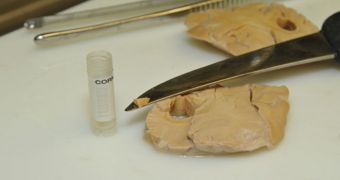The Indiana Medical History Museum holds a large collection of biological samples belonging to centuries-old brains, which researchers now plan to use to study the origins and history of mental illnesses. This work will be interesting, to say the least, and could be translated in practical applications as well.
At this point, the old brain samples are only displayed at exhibitions, and have no other practical roles. But a group of scientists believes these materials could be used to develop a new approach for treating mental conditions such as schizophrenia and bipolar disorders.
The museum was previously known as the Central Indiana Hospital for the Insane, which explains why it has the 400 samples neatly stored away. All the material was harvested during patient autopsies, mostly between 1896 and 1942.
Pathologist George Sandusky and his team, all from the Indiana University School of Medicine, began a long process of borrowing the samples one by one, taking them to their labs, and then analyzing each individual one under the microscope. The effort began nearly 2 years ago.
The main thing scientists are doing is extracting DNA samples from each of the brains, and then cross-referencing them with samples collected over the past few years. But the modern samples are also used as sources of potential biomarkers that may be indicative of particular conditions.
Working together with molecular psychologist Alexander Niculescu, Sandusky was able to pinpoint about 10 such biomarkers. At this point, the researchers cannot say whether all 10 are indeed suitable for this type of study, but at least they have something to go on.
Niculescu is currently checking to see if any of these biomarkers is present in the old brain samples. “We are curious if some of the recent insights with modern techniques might take us back in fact to the more unitary way mental illness was described in the past,” he explains.
“So it is a combination of genetics and history of medicine,” Niculescu adds. If the new investigation is successful, then it may become possible for doctors to establish mental illness diagnostics more efficiently in the future.
“We’ll be able to diagnose and predict treatment more quickly. We’ll know immediately what to prescribe,” Sandusky concludes, quoted by MEDILL.

 14 DAY TRIAL //
14 DAY TRIAL //